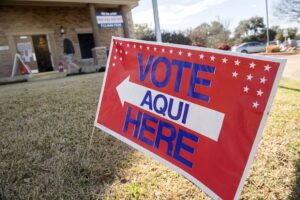You’ve heard of City Council members, and you know you have state representatives, too. Maybe you even know the name of your borough president.
But a district leader?
New York has an extra layer of elected representatives who exist, in theory, to help run the political parties in each county, which correspond to each of the five boroughs.
Traditionally, their duties include voting for party leadership, choosing poll workers and nominating judges.
But the unpaid, volunteer role can be what you make of it, and some use the district leader position to register voters, lobby for policy changes or connect New Yorkers to services.
“They’re able to do a lot of things that are not really defined,” said Richard David, a district leader in Ozone Park and Richmond Hill, Queens, since 2018.
For him, the job has involved pushing city government for more COVID testing capacity in his neighborhood, connecting those affected by Hurricane Ida with resources or helping to get an official designation for the area as Little Guyana.
“A lot of it is what you make of it,” he said.
Where do district leaders come from?
Though district leaders are volunteer positions, they are still elected officials and must be voted into the office every two years. They have no term limits.
The role is a holdover from New York’s hyper-partisan 19th Century, “when a well-connected local party boss could find a loyal constituent a job, an apartment or a key to getting out of jail,” The New York Times wrote in a 2019 obituary of a powerful former district leader, James McManus, the last boss of a political dynasty that ruled the West Side of Manhattan.
District leaders’ power has diminished over the course of reforms in the 20th Century, but their role is still enshrined in state law.
For John Blasco, who served as a Lower East Side district leader between 2019 and 2021, the job is an opportunity to recruit people to get involved in city politics.
“You’re helping to build up a Democratic Party. You’re doing it locally in your own Assembly District, and you’re contributing to the larger county,” he said.
And it’s tough, he added, because the process and system is so hard to parse. There’s typically been little information about district leaders, or the county system, readily available online or elsewhere.
“It’s so political. And it feels so underground,” he said. “Once you learn about it, you’re like, ‘I didn’t know I had all these micro elected officials!’”
In New York City, the Conservative, Republican and Democratic parties all have district leaders. Among the Democratic party, district leaders represent an area that corresponds to the state’s Assembly districts — but not always.
In Manhattan, a district leader represents one half, one third or one quarter of an Assembly district, depending on the area. The parts are labeled with an A, B, C or D. (Blasco represented the 74th Assembly District, Part A, for example.) In Queens, districts have a part A and B. All the other boroughs have two district leaders per one Assembly district — except for Assembly District 82 in The Bronx, which has two parts.
Got all that?
And to make things even more confusing, state law allows for each district to have one male and one female district leader, a rule all of the city’s five counties have adopted.
The concept is a spillover from the days of suffragettes like Eleanor Roosevelt, who pushed to mandate the male-female rule as a way to get more women involved in politics, WNYC previously reported.
To Émilia Decaudin, a trans woman currently serving as the district leader in the 37th Assembly District, Part A, in Queens, the tradition is outdated, and should be changed. She wrote and supports a bill in the state legislature that would allow nonbinary people to be eligible for party positions.
“I knew some people who might want to do this, theoretically,” she said, speaking of running for district leader positions. “And they couldn’t figure out how they would do so. It involves either having to lie about your identity and say that you are, you know, one or the other — or leaving it out or just putting an X instead of an M or an F.”
Doing that, she said, would “almost guarantee getting kicked off the ballot.”
What do district leaders do?
State law dictates very few rules for what district leaders do, leaving that up to the county political leadership to decide. But even among the parties, specific guidelines about their responsibilities are hard to find, said Decaudin. Instead, duties are a matter of tradition, not law.
For example, among the Democratic party in all five boroughs, if there is a vacancy on the county committee — the total voting body for a borough’s political party — the district leaders typically nominate new members. Why? It’s just how it’s always been, Decaudin said.
“This is a found right,” she said. “There’s no legal rule that says that district leaders appoint county committee members. It’s just that, that is how it works.”
That goes for several other duties of district leaders, including:
- Working with the city Board of Elections to nominate poll workers.
- Nominating candidates for judgeships in Civil and Supreme Court.
- Serving as a member of the county party’s executive committee, which votes for the party’s leadership.
Why do those jobs matter? Because they can have major sway over who represents New Yorkers.
For instance, county committees — whose members are often appointed by district leaders — are brought in to choose nominees in the case of special elections. That happened last fall when then-State Senator Brian Benjamin vacated his seat to become lieutenant governor.
Soon afterward, Manhattan’s Democratic county committee voted to nominate Cordell Cleare, former chief of staff to then-City Councilmember Bill Perkins, to take his spot. After she secured the party nomination, Cleare won the contest with 89% of the vote, a landslide.
Judgeships, too, nearly always go to the candidate with the backing of the party’s county committee. Often, judicial candidates also donate to the county’s party, as NYS Focus has reported.
Blasco said judicial candidates will “100% go to the district leader” and try to get their support.
“They have a really big influence. And oftentimes, sadly, it doesn’t matter what your qualifications are as a judicial candidate because if you have the right relationships with the right district leaders, they will put you in that seat,” he said.
Beyond that, however, district leaders can do as much as they are able, or want to do. Blasco said he used the job to educate both voters and potential candidates for office. Decaudin sees it, in part, as a way to bring visibility to endorsements and issues. David sees himself as a conduit to connect New Yorkers to information and resources — especially when people mistake him for a Council member, or Albany legislator.
“People will expect me to deliver things like funding or garbage cans … things that a district leader can’t possibly deliver,” he said. “But sometimes what I do is point them in the right direction — connect them with their elected officials, connect them with the constituent or legislative director within those offices.”
“And they end up being very happy with that kind of referral — so they’re not just venting anger in a Facebook group, which is what happens a lot,” he added.
How can I find out who my district leader is, or how to reach them?
First, find out which Assembly district you live in. The easiest way to do that is by looking up your address through the Board of Elections’ poll site finder. Bear in mind, however, that the 2022 redistricting process may have altered your political boundaries, so double check your district in these interactive maps we created of the new Assembly and Senate lines.
Some of the county’s political parties maintain lists of district leaders on their websites, and update them with varying frequency.
- Here is a list of the Democratic district leaders in The Bronx. Information about Republican district leaders could not be found through the Bronx County Republicans.
- Here is a list of Democratic district leaders in Brooklyn. The Kings County Republican Party does not list their district leaders.
- Here is a list of Democratic district leaders in Manhattan, and some from the Republican party.
- Here is a list of district leaders in Queens, from both the Democrats and Republicans.
- Neither the Staten Island Democrats or Republicans list district leaders in that borough.
If you cannot find your district or district leader, contact your party’s borough office directly.
This article was originally posted on What Is a District Leader? Your Guide to New York’s ‘Micro Elected Officials’











More Stories
Milwaukee’s election boss needs to stop ‘getting out the vote’
Early voting under way for Texas primary election runoff
Thousands of Arkansas residents cast ballots before Tuesday’s primary